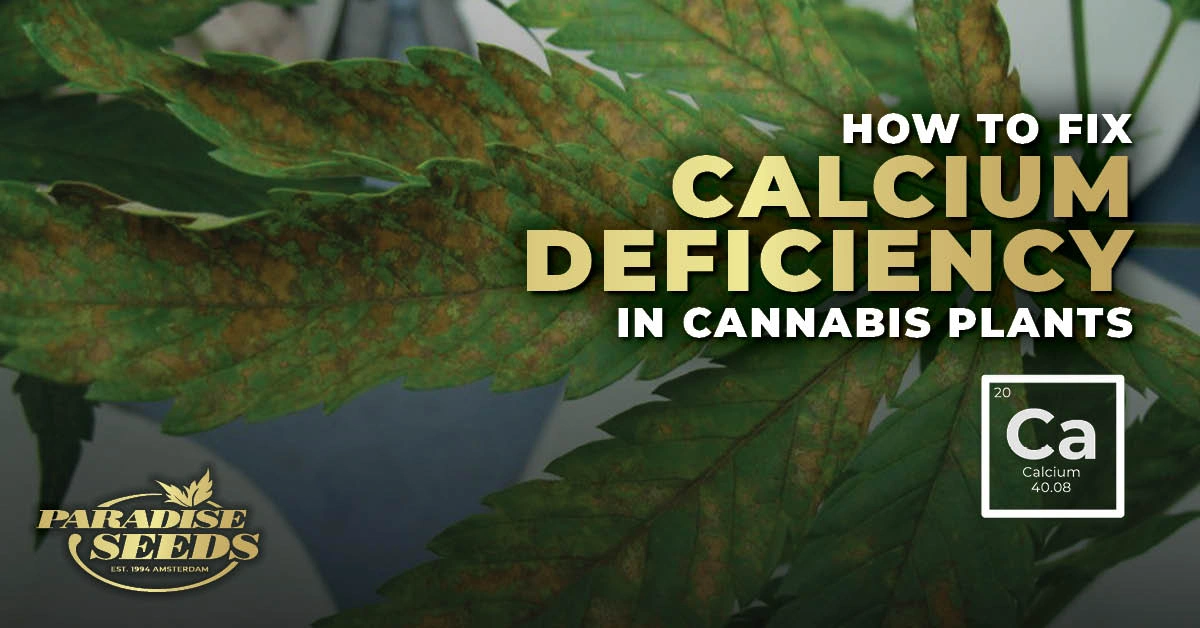Cultivating weed is a rewarding journey, but sometimes something gets in the way of an abundant harvest. A common issue is calcium deficiency in cannabis plants and final yield suffer significantly if you don’t detect it fast. So, how can you make the most of those feminized seeds or autoflowering seeds you bought and avoid a lack of this essential nutrient? We share why calcium is crucial for crops, how to spot a deficiency, and how to fix calcium deficiency in cannabis plants.
What does calcium do for cannabis?
Calcium deficiency in weed is terrible news for your weed plants. The nutrient is critical in the development of your crop as it:
- Aids nutrient absorption
- Assists root and flower production
- Holds the cell walls
- Helps transpiration
- Provides heat resistance
- Activates enzymes
- Ensures plant cell vitality
When marijuana crops can’t perform these processes properly, their health suffers, and so does their production.
What is cannabis calcium deficiency?
Calcium deficiency in cannabis plants means your plants aren’t getting enough of this vital nute. A few factors can cause the issue, including;
- A lack of nutrients in general
- Excess potassium or manganese
- Low medium pH
- Reverse osmosis water
- A highly-susceptible strain
Signs of calcium deficiency in cannabis cultivation
To fix the marijuana calcium deficiency in your crops, you need to know how to spot the problem. Luckily, cannabis displays various symptoms, helping you act swiftly to nip the issue in the bud.
A change in the foliage is one of the easiest ways to detect the deficiency. Leaves tend to discolor, display curled tips, and eventually die and fall off. New growth looks unhealthy, and the entire plant becomes brittle.
With weak roots and hollow stems, flower development is poor at best. As soon as you discover a lack of calcium, act fast before the effects become irreversible.
How to fix calcium deficiency in cannabis plants
You’ve detected calcium deficiency in cannabis and need to find a solution. Let’s take a closer look at a few remedies to implement.
Add dolomite lime
This method takes effect slowly over a few months. Adding dolomite lime is a simple way to reverse the problem in its early stages. Mix six teaspoons of the supplement with every gallon of your growing medium. Dolomite lime’s neutral pH of 7.0 maintains the ideal level for cultivating cannabis.
Supplements
Plenty of different nutrient supplements are available for your crops. Products with magnesium often contain calcium too. The balance is perfect for weed plants as a lack of one usually indicates there isn’t enough of the other.
Watch out for overfeeding with this technique. If you give crops too much, you risk them suffering from nutrient toxicity.
Adjust the pH
Most experts recommend flushing your plants and medium to reset the pH balance. You need a solution made from pH-neutral water and cannabis nutrients.
How to prevent calcium deficiency in weed
To avoid rectifying this gardening issue, try to prevent it before it occurs. Maintain the perfect environment for your crops to flourish by;
- Providing the correct amount of nutrients for each growth stage
- Ensuring the pH of your grow medium is in the optimal range (5.8–6.2 for soil and 5.5–6.5 for hydroponics)
- Watering plants with pH-neutral water
What is calcium toxicity?
Calcium toxicity is the opposite of a deficiency. While the mineral is essential for your plants to thrive, too much disrupts the ion balance and causes damage. When there’s too much of this nutrient in your growing medium, crops suffer from leaf burn and lock out other nutes.
If your marijuana experiences calcium toxicity, flush the plants. Opt for soft water and blend with a low dose of nutrients. You wash away the excess but leave adequate quantities for continued development.
Act fast and save yields!
As a 420 grower, you may face calcium deficiency; cannabis displays many symptoms to help you identify the problem. Fix the issue swiftly to avoid affecting your final harvest. Not started cultivating yet? Pick up a bag of seeds today to begin your journey. The above tips can get you out of trouble and allow you to reap the rewards of your gardening efforts.


